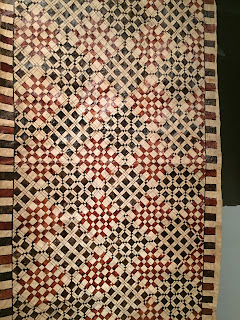I so have enjoyed my visits to the Denver Art Museum lately--not only for their fine art collections but for the textile exhibits that have been featured this summer.
This exhibit was fascinating to me!
There are textiles--even if you need to find them in tree bark!
Bark cloth is a versatile material that was once common in Asia, Africa, Indonesia, and the Pacific; mainly comes from mulberry or tapa tree.
Of course, we think of using bark cloth as floor or wall coverings
But, for many natives of the islands, it was used for their clothing items
What really got me was how lively the colors were
Design work was usually stamps or rubbings from carvings
intricate designs to look like lace
Tapa can be decorated by rubbing, stamping, stenciling, smoking (Fiji: "masi Kuvui") or dyeing. The patterns of Tongan, Samoan, and Fijian tapa usually form a grid of squares, each of which contains geometric patterns with repeated motifs such as fish and plants, for example four stylized leaves forming a diagonal cross. Traditional dyes are usually black and rust-brown, although other colours are known.
In former times the cloth was primarily used for clothing, but now cotton and other textiles have replaced it. The major problem with tapa clothing is that the tissue loses its strength when wet and falls apart
Nowadays tapa is often worn on formal occasions such as weddings. Another use is as a blanket at night or for room dividers. It is highly prized for its decorative value and is often found hung on the walls as decoration.
In Tonga a family is considered poor, no matter how much money they have, if they do not have any tapa in stock at home to donate at life events like marriages, funerals and so forth. If the tapa was donated to them by a chief or even the royal family, it is more valuable. It has been used in ceremonial masks in Papua New Guinea and the Cook Islands (Mangian masks). It was used to wrap sacred objects, e.g., "God staffs" in the Cook Islands
This is a copy of a carving that could be used for rubbings
"ele is one of the uses of color--check out the info
Yes, we can find useful ways to achieve clothing from many different native plants and trees.




















































